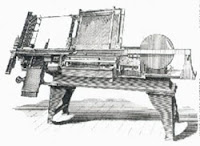
Did you know that Samuel Clemens suffered a business failure that forced him into bankruptcy? Somehow this chapter of Samuel Clemens' life has managed to escape my attention until quite recently.
The business failure was related to an automatic typesetting machine called the “Paige Compositor”. From a description on the site of the Mark Twain House:
The Paige Compositor was an automatic–typesetting machine invented by James W. Paige. Little is known about the inventor of the Paige Compositor. James W. Paige was born in upstate New York in January 1842. While living in Rochester, he applied for his first patent on a typesetter in 1872, and the patent was granted in 1874. He then moved to Hartford between 1874–77 to work for the Farnham Type–Setter Company, which was trying to put together a workable typesetter by combining the gravity-fed Farnham machine with the Thompson distributor. The Farnham Type–Setter Company rented space for about five years at the Colt Firearms factory. The rest of Paige’s life centered around the Paige Compositor, trying to market it and make it work. Paige eventually died in the poorhouse, but no one knows where or when.
Twain’s love for technology and his background in printing led him to invest in the compositor. Between 1880 and 1894 he invested a fortune into its development, resulting in his near bankruptcy. In an 1889 letter to his brother Orion, Twain writes,
“All the other inventions of the human brain sink pretty nearly into commonplaces contrasted with this awful mechanical miracle. Telephones, telegraphs, locomotives, cotton gins, sewing machines, Babbage calculators, Jacquard looms, perfecting presses, Arkwright’s frames – all mere toys, simplicities! The Paige Compositor marches alone & far in the lead of human inventions."
The Paige Compositor was, by all accounts I’ve found, a jaw-droppingly astonishing kind of machine. It had over 18,000 parts and could set type faster than its competitor (the Linotype machine) — when it worked. But it was failure-prone, and very difficult and expensive to manufacture. The inventor was a perfectionist who didn’t want to go to market with a less-than-perfect machine — and so was beat to market by several years by the Linotype. There are lots of parallels here in my own industry (software).
In a biography of Sameul Clemens (by Albert Bigelow Paine, available online), there’s a good discussion of this episode. A sample:
By the end of ’88 the income from the books and the business and Mrs. Clemens’s Elmira investments no longer satisfied the demands of the type-setter, in addition to the household expense, reduced though the latter was; and Clemens began by selling and hypothecating his marketable securities. The whole household interest by this time centered in the machine. What the Tennessee land had been to John and Jane Clemens and their children, the machine had now become to Samuel Clemens and his family. “When the machine is finished everything will be all right again” afforded the comfort of that long-ago sentence, “When the Tennessee land is sold.”
They would have everything they wanted then. Mrs. Clemens planned benefactions, as was her wont. Once she said to her sister:
“How strange it will seem to have unlimited means, to be able to do whatever you want to do, to give whatever you want to give without counting the cost.”
It’s an interesting read, worth it if you are at all interested in Samuel Clemens.
More information about the Paige Compositor here, here, and here…


